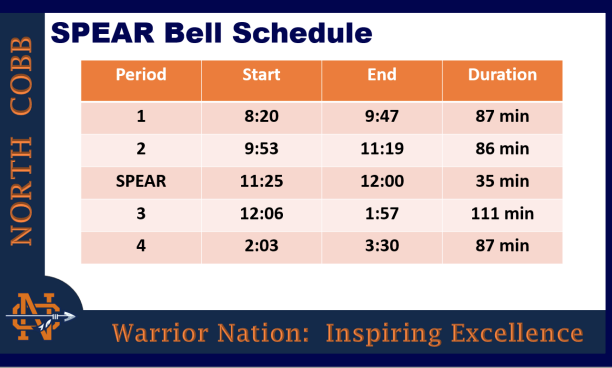NEWS: SPEAR
Reminiscent of the previously implemented “Warrior Wednesdays”, SPEAR more successfully benefits students and teachers with its improved organization and setup. “Warrior Wednesday, as it was originally conceived, was more about enrichment and the idea that kids could choose what class they went to. If they needed help in a certain class they were basically required to go get help from that particular class. The hard part was it was really difficult to systematically keep track of who was going where and what they were doing. It was a loose or very chaotic situation at times from a school supervision standpoint,” Magnet Coordinator James Auld said.
August 21, 2019
A new school year marks change at NC. Change in school policies, mottos, and most notably, class schedules. SPEAR, which stands for Support, Preparation, Enrichment, Acceleration, and Remediation, officially began August 19.
“SPEAR is designed so teachers can implement targeted and specific support and instruction for students weekly. It is an expectation that all students are actively engaged and working during this time,” Assistant Principal Lexie Bultman said.
“SPEAR time”, as teachers and administrators sometimes refer to it, occurs between second and third period (beginning at 11:25 a.m. and ending at 12 p.m.) and gives teachers an extra 35 minutes for instruction and activities. Strategically placed, the time in which the period ensues makes it difficult for students to skip.
“You can’t necessarily have a morning or afternoon period because kids just skip it, and if you actually believe you’re going to push your best kids and help struggling kids, then you have to have kids come to it or it doesn’t work. When you put it right after second period, anyone who comes late won’t miss that remediation or enrichment period and if they leave early for work-based learning or internships or just minimum day, they don’t miss it either,” Magnet Coordinator James Auld said.
As implied by the acronym, the schedule change hopes to offer remediation to struggling students and enrichment for students who find themselves unchallenged in a class. Teachers can also use this time to instruct students on topics outside their curriculum that they find interesting or enjoyable and wish to share with their classes.
“Teachers were excited about being provided the opportunity to help move all students forward and will plan, develop, and implement strategies to help students be more successful in their classes. We hope to see more students be successful and demonstrate growth in all areas,” Bultman said.
As students and teachers settle into a new routine, NC expects to see academic growth and steady graduation rates within the student body.




